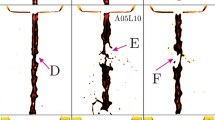Abstract
The highly ramified patterns1,2 produced by the flow of a reactive fluid through a soluble porous medium have never been quantitatively described. The theoretical understanding of this phenomenon is limited to very simple conditions (such as the flow of a liquid through a; capillary3) due to the complexity of the coupling between the chemical reaction and the fluid flow. We show here that the dissolution patterns (DP) obtained experimentally by injecting water through pure plaster are fractal, for different geometries of the samples. In two dimensions, these DP are remarkably'similar to patterns associated with diffusion-limited aggregation4–6 (DLA), that is, dielectric breakdown7, viscous fingering8,9 and diffusion-limited polymerization10. In three dimensions, we compare them with DLA clusters grown in the same boundary conditions and find a good qualitative and quantitative similarity. These results should be of interest in different areas where chemical dissolution of porous media by a flowing fluid occurs, for example, in nature (the formation of caves) and in industry (in the oil industry where acids are routinely injected into oil reservoirs).
This is a preview of subscription content, access via your institution
Access options
Subscribe to this journal
Receive 51 print issues and online access
$199.00 per year
only $3.90 per issue
Buy this article
- Purchase on Springer Link
- Instant access to full article PDF
Prices may be subject to local taxes which are calculated during checkout
Similar content being viewed by others
References
Ewers, R. O. Thesis, McMaster Univ., Hamilton. Ontario (1982).
Lee, P. B. & Mason, G. I. Chem. E. Jubilee Symp. Ser. 73, A13–21 (1982).
Levich, V. G. in Physicochemical Hydrodynamics (ed. Scriven, L. E.) 112–16 (Prentice-Hall, Englewoods Cliffs, 1962).
Witten, T. A. & Sander, L. M. Phys. Rev. Lett. 47, 1499–1501 (1981).
Witten, T. A. & Sander, L. M. Phys. Rev. Lett. B27, 5685–5697 (1983).
Meaking, P. Phys. Rev. A27, 604–607 (1983).
Niemeyer, L., Pietronero, L. & Weismann, H. J. Phys. Rev. Lett. 52, 1033–1036 (1984).
Måløy, K. J., Feder, J. & Jøssang, T. Phys. Rev. Lett. 55, 1885–1891 (1985).
Daccord, G., Nittmann, J. & Stanley, H. E. Phys. Rev. Lett. 56, 336–339 (1986).
Kaufman, J. H. et al. Phys. Rev. Lett. 56, 1932–1935 (1986).
Brady, R. M. & Ball, R. C. Nature 309, 225–229 (1984).
Meakin, P. Phys. Rev. A27, 2616–2623 (1983).
Rácz, Z. & Vicsek, T. Phys. Rev. Lett. 51, 2382–2385 (1983).
Meakin, P. Phys. Rev. B30, 4207–4214 (1984).
Nittmann, J., Daccord, G. & Stanley, H. E. Nature 314, 141–144 (1985).
Hentschel, H. G. E. & Deutsch, J. M. Preprint (Massachusetts Insitute of Technology, 1986).
Daccord, G. Phys. Rev. Lett. (in the press).
Author information
Authors and Affiliations
Rights and permissions
About this article
Cite this article
Daccord, G., Lenormand, R. Fractal patterns from chemical dissolution. Nature 325, 41–43 (1987). https://doi.org/10.1038/325041a0
Received:
Accepted:
Issue Date:
DOI: https://doi.org/10.1038/325041a0
This article is cited by
-
Evaporative destabilization of a salt crust with branched pattern formation
Scientific Reports (2023)
-
Dissolutive flow in nanochannels: transition between plug-like and Poiseuille-like
Microfluidics and Nanofluidics (2018)
-
Micro-continuum Approach for Pore-Scale Simulation of Subsurface Processes
Transport in Porous Media (2016)
-
Control effects of Morlet wavelet term on Weierstrass–Mandelbrot function model
Indian Journal of Physics (2014)
-
Effect of Efflorescence Formation on Drying Kinetics of Porous Media
Transport in Porous Media (2009)
Comments
By submitting a comment you agree to abide by our Terms and Community Guidelines. If you find something abusive or that does not comply with our terms or guidelines please flag it as inappropriate.



